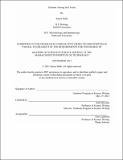Humans Among the Clouds
Author(s)
Sidik, Saima
DownloadThesis PDF (205.5Kb)
Advisor
Mnookin, Seth
Terms of use
Metadata
Show full item recordAbstract
For over 100 years, scientists have trekked to an observatory on top of Blue Hill in Milton, Massachusetts to observe and record the weather. When the Observatory was founded in 1885, scientists’ understanding of Earth’s atmosphere was still too limited for them to reliably predict the next day’s weather. Today, a global network of satellites, weather balloons, airplanes, and ocean buoys makes Blue Hill’s contribution to day-to-day weather prediction minimal, and yet the Observatory has found itself at the center of a looming crisis — climate change. Throughout the decades, Blue Hill scientists have stayed deeply committed to consistency. They continue to use thermometers, barometers, anemometers, and other equipment from as far back as the 1800s to avoid disrupting their record by changing their instrumentation. As a result, records from Blue Hill and similar sites are some of the most reliable indicators that the Earth’s climate has shifted in a small, but meaningful, way. Old equipment is difficult to maintain, however, and justifying their seemingly-arcane methods to the lawmakers who control their budget can be challenging. As technology evolves, and automation sweeps through disciplines ranging from meteorology to medicine, will Blue Hill weather observers be able to maintain their way of life? And what will science lose if they can’t?
Date issued
2021-09Department
Massachusetts Institute of Technology. Graduate Program in Science WritingPublisher
Massachusetts Institute of Technology